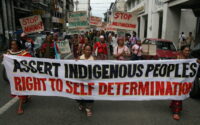Misinformation and Race in Journalism: Response to Annabel Gorman’s Podcasts Blog Post
By Alexis Jones

Though podcasts, due to their lack of regulations, are a media form that can carry misinformation, misinformation is a danger that can present itself in any type of media. Misinformation, information given that incorrect or misleading without malicious intent, is often displayed in white media through exclusion of diverse perspectives and imposing a requirment of objectivity.
The documentary film, “Angry Inuk” follows the story of Inuits who have to fight against animal rights groups propaganda that harms the Inuit livelihood. Inuit sealers rely on seals as a food and oil source and an economic resource by selling seal skins. However, within the past few decades, animal rights groups’ seal protection initiatives have led to bans that harm Inuit’s ability to sell seal skins which affects their communities’ ability to provide for themselves and have a stable income. Animal rights organizations targeting sealers are perpetuating misinformation as they are plastering photos of baby white seals as an emotional draw to their viewers. However, as the documentary shared, hunting of white seals has been banned in Canada for years and is not done. The greatest form of misinformation is that these activist groups are not telling the story of how these bans are affecting Inuit seal hunters.
Misinformation in seal activism is just one example of how the media creates misinformation by excluding diverse opinions in news stories. Oftentimes misinformation in the form of racial prejudice is not seeking to harm, but do as they perpetuate racist systems. Part of the reason that misinformation of the Inuit people was so prevalent in this movement was due to a lack of racial inclusivity. Only white saviors were sharing their side of the story, yet again. Lack of inclusivity in media and journalism is a problem that is a tale old story.
Nafari Vanaski, a former reporter in Pittsburg, details an example of her relationship with journalism and race as an African American reporter. One factor that affects racism in journalism is the role of objectivity. “Racism is well-baked into all the institutions in our country, and journalists are told to remain objective. So any attempt to point out flaws in a racist system, especially by a Black reporter, is usually met with some sort of lecture, often from a White editor, about how important it is for news writers to remain neutral” (Vanaski, 2020).
Objectivity is just one way that racial issues have created tension in journalism. Lack of focus on diverse stories is another issue that can create misinformation as only white voices are being highlighted. This is a problem as “It’s any reporter’s job to raise awareness on important issues, so that people understand them, where they came from, how they affect people today and what we can do about it” (Gilpin, 2018).
You have to include diverse racial perspectives in order to tell well-rounded stories. Just telling the stories of racial groups is not enough. How you tell these stories is critical as well. In a 2018 story by National Geographic detailing their errors in reporting, they stated that they wrote stories about race that did not “simply emphasize difference, but made difference…very exotic, very strange, and put difference into a hierarchy…[where] the English speaking world, was at the top of that hierarchy” (Wamsley).
Gorman writes that a “many [podcasts] are from organizations that either require payment or operate as a commerical entity” (Gorman, 2021). This has a direct effect on misinformation as the voices being heard are often those with the money to share their voices which in our society tends to predominately be upperclass white males. Another result of podcast media is that speakers want to get more attraction which can be acheived by fitting within the status quo. This is dangerous and leads to a lack of diversity of voices and ideas as show hosts are conforming to corporate media which has an elite white audience. It is crucial that podcasts hosts take a step back and educate themselves on the ways that their topics overlap with diverse perspectives and include those perspecitves in their shows.
The media has a responsibility to report fairly and accurately as part of the tenets of good journalism. So whether the story is being told through a podcast or in an online news article, there is no room for misinformation or racial prejudice in good journalism.
Gorman, Annabel. (2021, October 22). Podcasts: a tool for freedom of speech or misinformation? Environmental Journalism WordPress.
Arnaquq-Baril, A. (Director). (2016). Angry Inuk [Video file]. Film Movement.
Gilpin, Emilee. (2018, December 11). Indigenous journalists speak up. Canada’s National Observer.
Vanaski, Nafari. (2020, July 13). “Objectivity” in journalism perpetuates racism. Zora.
Wamsley, Laurel. (2018, March 12). ‘National Geographic’ reckons with its past: For decades, our coverage was racist. npr.
This story was updated on 12/7/2021. The primary changes include links to citations within the body of the work, providing a definition for misinformation, clarify the connection between misinformation and perpetuation of racial systems even when their is not an intention to harm, integration of white media’s hand in misinformation into my thesis, and more direct application to Annabel Gorman’s blog post and the role that podcasts play in perpetuating misinformation by conforming to corporate media.


